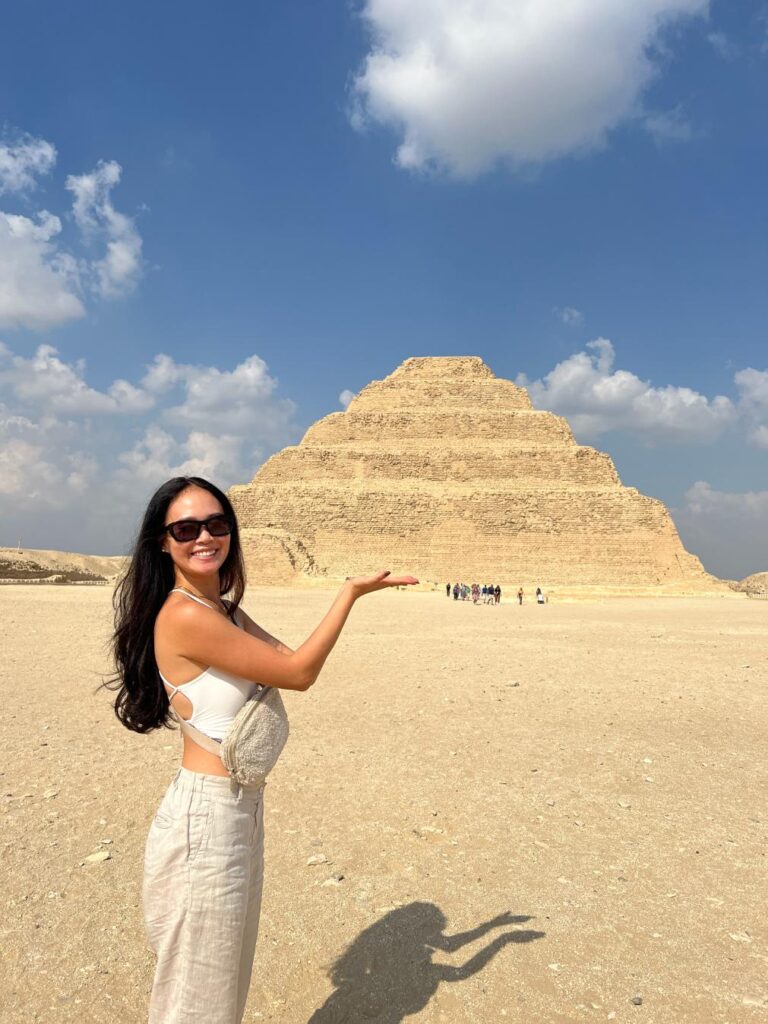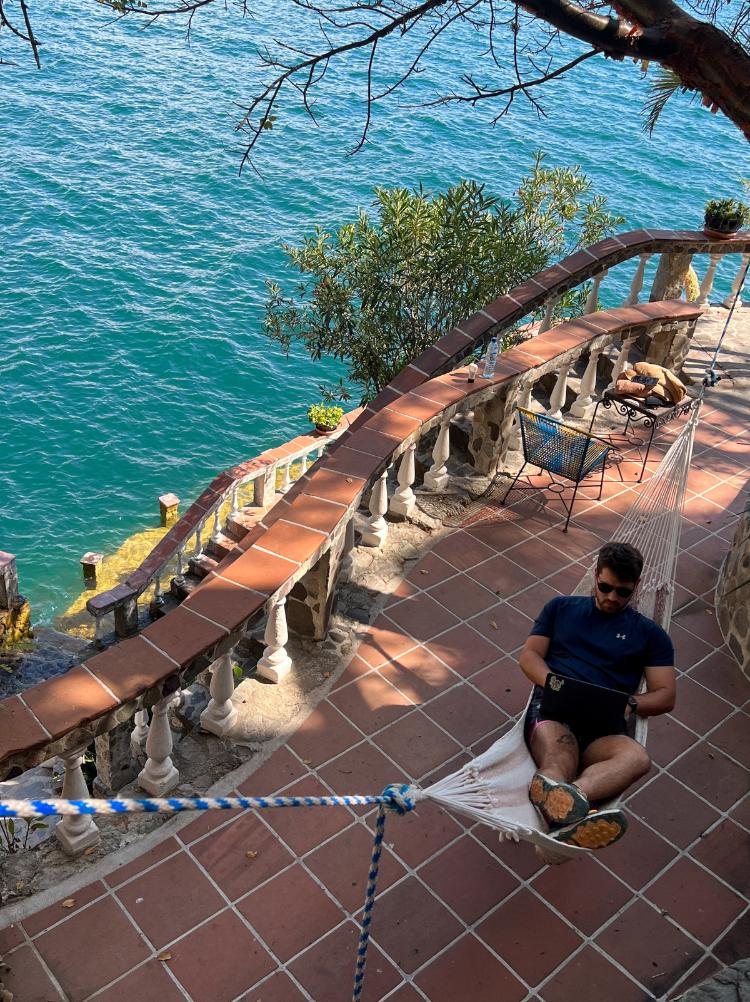In a world obsessed with checking off countries and squeezing the most into every trip, slow travel is a refreshing alternative. Slow travel prioritizes authentic experiences and connections over seeing everything.
Slow travel completely changed our lives and allowed us to full-time travel for the past 3 years. This travel style is all about being more present during your trips and maintaining a healthy lifestyle while on the move.
In this article, we will argue why more travelers should consider slowing down, provide some of the main benefits, and break down how to slow travel.
Disclaimer: This blog post includes affiliate links, which means we receive a tiny commission – at no extra cost to you. Don’t worry; this doesn’t affect our recommendations whatsoever. It just helps us keep the lights on.
What Is Slow Travel?


Slow travel is pretty much exactly what it sounds like: a style of travel in which you spend more time in each destination. Slow travel is all about quality over quantity. Instead of packing in as many destinations as possible in a short itinerary, slow travelers prioritize specific bucketlist destinations and give themselves enough time to truly “get to know” a place.
Look, we get it. You can only take one major vacation per year, and you want to do as much as possible to maximize your trip. We aren’t asking you to strip down your travels completely. Slow travel is simply an argument for being more mindful about your trip planning and focusing on developing connections with destinations.
So, what exactly does “slow travel” look like? There is no strict definition. It might mean spending your entire trip in one city, or simply resisting the urge to overbook your days so you have time to wander and discover things spontaneously. Slow travel is less about a rigid formula and more about creating space to actually experience a place, not just check it off your bucket list.
Fundamentals of Slow Travel
- Spend longer in each destination
- Prioritize “chill days”
- Leave room in your itinerary for spontaneity
Why You Should Consider Slow Travel


We truly believe that every traveler can benefit from some form of slow travel. Whether you are taking your annual vacation or embarking on a 6-month-long backpacking trip, slowing down your travels can transform your relationship with a destination. Here are some of our top arguments for slow travel.
It’s More Affordable
When you spend more time in each destination, your trip will likely cost less. It’s much easier to cut back on your travel expenses, particularly when it comes to accommodation and transportation. For example, many travel accommodation platforms (Booking.com, Airbnb, VRBO) offer 10-30% discounts on weekly or monthly bookings.
Also, since you’ll be spending more time in each destination and less time in transit, you’ll pay significantly less for transportation. For example, a train, bus, or flight between cities can set you back $30 to $80 per journey on average.
When you slow travel, you also tend to save on food, activities, and other travel expenses.
Below is a cost comparison of two one-month trips: one that includes 8 different cities, and one that takes a slower approach, visiting just 4 destinations.
| Factor | Fast Travel (8 Cities) | Slow Travel (4 Cities) |
|---|---|---|
| Accomodation | $2,000 | $1,400 |
| Transport | $600 | $250 |
| Food | $900 | $750 |
| Activites | $500 | $350 |
| Total | $4,000 | $2,750 |
🛑 WAIT! Don’t forget insurance!
SafetyWing’s Nomad Insurance is a travel medical insurance for nomads by nomads. You can sign up for as little as $2 a day to cover your travel and medical needs while on the go ✈️🌏
Easier to Keep Up a Routine
Maintaining a healthy routine while traveling has been one of our biggest struggles. When every day is different, it’s hard to stick to habits like working out, eating healthy, or getting enough rest. This lack of routine is one reason many longer-term travelers eventually burn out.
When you slow down your travels, you’ll have the opportunity to keep up your habits while still experiencing a new place. Without such a packed itinerary, it’s easier to make time for things like exercising, reading, or other hobbies while on the move.
For example, one of our favorite ways to explore a new city is to go on a morning run. Running in a new place is like knocking out two birds with one stone. You’ll get some good exercise while doing some sightseeing at the same time!
Here are some tips for keeping up with your routine while traveling:
- Set aside time in your itinerary for your hobbies when planning your trip
- Sign up for a short-term membership at a local gym
- Stay in accommodations with a kitchen so you can cook your own healthy meals
- Try to wake up and go to sleep at the same time every day
With more rest, healthy eating, and exercise, you’ll have more energy to enjoy your travels and will likely be able to maintain the “nomadic” lifestyle for longer.
It’s More Sustainable
We are major advocates for traveling sustainably. The travel industry has a pretty negative effect on the environment, so it’s important to be mindful about this and attempt to minimize your impact where possible. Slow travel is an excellent way to continue seeing the world while simultaneously reducing your footprint and having a more positive impact on the communities you visit.
Slow travelers take fewer flights, which can significantly reduce your carbon footprint. In fact, air travel accounts for about 2.5% of global CO₂ emissions.
And because you’re not racing from place to place, you’re more likely to take lower-emission transport like trains, buses, or even bikes and walking.
Slow travel also helps reduce pressure on overcrowded destinations. Instead of contributing to the strain on local infrastructure by rushing through with thousands of other tourists, you can support more sustainable travel practices like staying in local accommodation, shopping at markets, and engaging in ways that distribute your impact more evenly.
For more on sustainable long-term travel, check out our guide on ethical digital nomad practices.
Form Deeper Connections with Destinations
When you spend just 2 or 3 days in a city, it’s almost impossible to explore past the surface-level tourist attractions. You’ll see the major landmarks and attractions listed in every guidebook, but you simply won’t have the time to have a unique experience. Many travel destinations have a trodden “tourist path” that few visitors venture past.
It makes sense. Let’s say you visit Rome for 3 days. You are obviously going to want to fill your itinerary with the classic sites like the Colosseum, Pantheon, Vatican City, and Trevi Fountain. However, with only 3 days in the city, you won’t have much time to sip espresso in a neighborhood cafe or explore a local market.
Slow travel shifts the focus. Sure, you’ll still have the opportunity to visit the main sites, but you’ll also see and experience much more outside of the tourist circuit. Instead of spending every day of your trip traversing the city, visiting museum after museum, you can spend your days in specific areas with more downtime to read a book in a park or visit a local neighborhood. As a slow traveler, you can get a real sense of how locals live and discover spots that aren’t listed on TripAdvisor.
You’ll Maintain a Sense of Community
Another challenge of travel, especially if you travel full-time like us, is making meaningful connections and creating a sense of community. Travel can be isolating. While you’ll inevitably meet new people every day, if you are constantly moving from place to place, you’ll struggle to feel truly rooted anywhere.
The benefit of slow travel is that you’ll have more time and energy to make deeper connections with people in your host community. We spend a minimum of a month in every city we visit, so we have more opportunities to not only make new friends but also feel more at home in a new place.
Here are a few great ways to get connected:
- Join weekly run clubs
- Attend expat or digital nomad events
- Take a language class
- Attend recurring events like trivia nights or workshops
Less Fatigue, Fewer Travel Days
One of the most obvious benefits of slow travel is that you spend less time moving from place to place and more time actually experiencing a destination. Long or frequent travel days are one of the biggest contributors to fatigue.
Think about it this way: if you are taking a 2-week vacation, and choose to visit 5 cities, you’ll be spending every third day in transit. But if you visit just 2 destinations, you’ll cut down significantly on travel time.
How to Slow Travel: 7 Ways to Do it


Choosing to slow travel is one thing, but putting it into practice is another. Here are some of our top tips and tricks for slow traveling.
Intentionally Give Yourself More Time in Each Destination
The easiest way to get started with slow travel is to simply give yourself more time in each place. If you think you need an absolute minimum of 3 days to see everything you want to see in a city, book at least 5 days. This allows for more flexibility and spontaneity during your stay.
Back-to-back sightseeing marathons can leave you feeling exhausted rather than fulfilled. Extra buffer days give you time to rest without feeling guilty.
Use a Destination as a Home Base for Your Trip
This is one of our favorite slow travel approaches. Instead of picking up and moving every few days, book your entire trip in a single city and take day trips to explore the surrounding area. Rent a car, or if you are in a region with good public transportation, take the train to a nearby city.
This approach is especially feasible in Europe. European cities are well-connected by train, so regional travel is easy. For example, we used Florence as a home base while staying in Italy for a few months. From there, we explored surrounding Tuscan villages like Lucca and Pisa and even took a day trip to Bologna, which is just 30 minutes away by train.
Using a city as a home base for your travels allows you to maintain comfort and convenience without missing out on everything the surrounding region has to offer.
Work Remotely
Being able to travel slowly is often easier said than done. Stretching your budget for long-term travel can be a major challenge, especially if you don’t have any consistent income. The best fix for this? Work remotely!
Slow travel and the digital nomad lifestyle often go hand-in-hand. After all, if you are working remotely, you’ll need to spend more time in each destination to give yourself time to get work done.
We know what you might be thinking: “The last thing I want to do is work during my travels”. That said, being a digital nomad doesn’t have to involve working full-time. There are many different jobs for remote workers that allow you to earn at least a bit of income to fund your travels.
For example, you could:
- Teach English to students online
- Help out with basic data entry or administrative tasks
- Create user generated content (UGC)
- Sell digital products on Etsy
- Capitalize on your skills on platforms like Upwork and Fiverr
Want to Take the First Steps to Becoming a Full-Time Traveler?
Download our FREE ebook on the best platforms for finding remote work and subscribe to our newsletter

Limit your Itinerary to a Single Region or Country
Trust us. We know how tempting it can be to pack your travel itinerary with everything you want to see. We’ve met countless travelers in Europe who try to cram 10+ countries into a 3-week itinerary. This sounds like an absolute nightmare for us. Exhaustion and burnout aside, you really won’t get to fully experience a country if you only visit for a few days. One way to naturally slow down your trip is to restrict your trip to a specific country or region. Instead of attempting to see 5 different countries in a short period, visit one and see several different cities, towns, or natural areas within the country. This will naturally slow down your travels, and you’ll likely have much shorter travel days.
Consider Working Holiday Visas
If you are interested in experiencing what it’s like to live in a different country, consider applying for a working holiday visa. These visas allow you to stay in a country for up to a year and work while you are there. Working holiday visas are available in a handful of countries, but your eligibility will depend on your country of residence and your age (most require you to be between 18 and 30).
The most popular countries with working holiday visas around the world are:
- Australia
- New Zealand
- Canada
- Ireland
- South Korea
- Italy
- United Kingdom
Volunteer Abroad
Another way to naturally slow down your trip is to join volunteer programs or work in exchange for free accommodation and meals. There are countless volunteer opportunities for travelers around the world. This is a great way to make genuine connections in a new country and visit destinations that you otherwise wouldn’t have the opportunity to see.
Here are some of the best ways to volunteer abroad:
- Workaway: We’ve used this platform several times. You’ll pay an annual fee, but then you can apply for volunteer jobs around the world.
- Worldpackers: Similar to Workaway, with more filtering options and a free membership.
- AuPairWorld: Best platform for finding au pair opportunities around the world. The membership is free; you simply set up a profile and can start applying to become an au pair.
- Volunteer at hostels: Another way to volunteer is to simply get in touch with hostels in different countries. Hostels are always looking for volunteer help, so this is a great way to cut back on your expenses while traveling.
Slow Travel Struggles and Downsides
Like just about anything, slow travel isn’t all sunshine and rainbows. Here are a few of the biggest cons of traveling slowly.
You’ll Visit Fewer Places
One of the major trade-offs of slow travel is that you won’t check as many countries or cities off your list. If you’re the type of traveler who wants to see as much as possible in a short time, this may not be the travel style for you.
Visa Limitations Can Be Restrictive
In many countries, you’ll only be allowed to stay in a country for between 30 and 90 days. For the standard traveler, this may not seem too limiting, but if you’re hoping to spend several months in one place, you’ll need to research visa extension options or apply for a working holiday visa in advance.
You’ll Spend More Time Planning
While slow travel generally means you visit fewer destinations, it doesn’t mean you are off the hook when it comes to planning. In fact, you’ll likely find yourself spending more time researching visa requirements, long-term accommodation options, coworking spaces, and local events. We spend hours researching and calculating when determining if a destination is a good option for us.
Slow travelers need to think more about logistics like foreign SIM cards (we use eSIMS to make it easier; our top picks are Holafly, Airalo, and Saily), transit passes, and travel medical insurance.
Make the Shift to Slow Travel
Traveling slowly isn’t difficult. Start small by adding an extra day to a destination or simply leaving space in your schedule to explore without a plan.
Looking for more advice on traveling slow and making the most out of your trips? Join our mailing list! We send out monthly newsletters with our top travel tips and actionable advice on traveling longer and more sustainably!
Subscribe to our newsletter!




